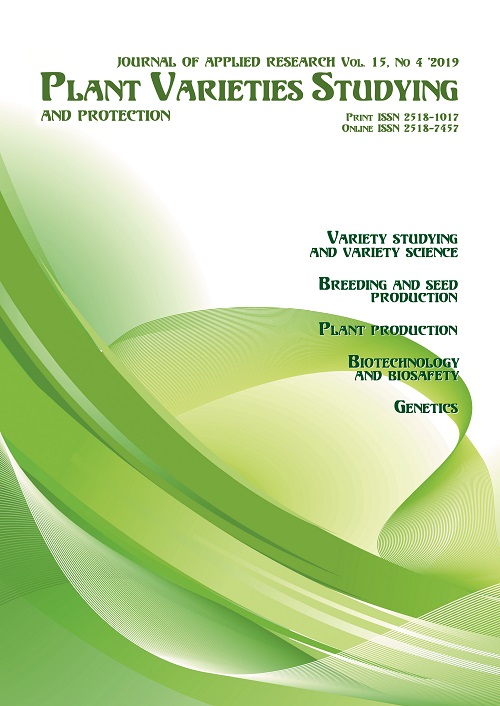Analysis of the Ukrainian collection of common hop varieties (Humulus lupulus L.) to highlight varieties with reference characters
DOI:
https://doi.org/10.21498/2518-1017.15.4.2019.188551Keywords:
Humulus lupulus L., variety, sign, standard, code of display, collection of hop, identificationAbstract
Purpose. Conduct a generalized assessment of samples of the base collection of hops Humulus lupulus L. Institute of Agriculture Polissia of NAAS of Ukraine according to the level of manifestation of the main morphological characters to highlight domestic varieties with reference characters.
Methods. Field, visual estimation, laboratory, analytical.
Results. During 2011–2017 samples of the base collection of Humulus lupulus L. hops were evaluated in the conditions of Polissia; the level of manifestation of their main morphological characters was determined. An information base has been formed on the morphological characteristics of hop varieties with a list of foreign standard varieties and domestic applicants for standards on certain characteristics. It was revealed that breeds have varying degrees of characters manifestation. In particular, according to the intensity of the anthocyanin color of the stem from very weak – ‘Slavianka’, ‘Zahrava’ to very strong – ‘Hranit’; according to the color of the upper part of the leaf blade: from yellow-green, characteristic for the ‘Alta’ and ‘Khmeleslav’ varieties to green, for the ‘Zahrava’ and ‘Clon 18’ varieties. By flowering time and onset of technical ripeness of cones, the varieties are divided into groups: early – ‘Alta’, medium – ‘Clon 18’, ‘Zahrava’, later – ‘Xanta’, ‘Haidamatskyi’, ‘Hranit’. Among domestic applicants for standards in the form of a bush, the variety ‘Zmina’ – spindle-shaped, ‘Slavianka’ – cylindrical, ‘Alta’ –conical, and others; in the shape of a cone – variety ‘Clone 18’ – cylindrical, ‘Slavianka’ – narrow oval, ‘Ruslan’, ‘Alta’ – oval, ‘Zlato Polissia’ – wide oval and ‘Zhytych’ – spherical.
Conclusions. Based on the results of long-term investigations, a comparative assessment of the reference varieties of foreign breeding and samples of the collection of domestic origin was carried out according to the characteristics of the vegetative (stem, leaf, bush), plant generative organs (cone) and phenological descriptions (time of flowering and cone harvesting), which allowed to determine the varieties with stable manifestation of the main identification signs of hops. Domestic varieties that are carriers of individual (‘Zlato Polissia’, ‘Zhytych’, ‘Ruslan’, ‘Poliskyi’) or several traits (‘Slavianka’, ‘Zahrava’, ‘Haidamatskyi’, ‘Clon 18’, ‘Khmeleslav’, ‘Alta’, etc.) are isolated and proposed for use as standards.
Downloads
References
Shtanko I. P. (2013). Achievements breeding of hop in the world and the direction of improving the structure of varietal plantings in Ukraine. Agropromyslove vyrobnycztvo Polissya [Agricultural ndustry of Polissya region]. 6. 92–97. [in Ukrainian].
UPOV. (2002). TG/1/3. General introduction to the examination of distinctness, uniformity and stability and the development of harmonized descriptions of new varieties of plants. Geneva: UPOV. Retrieved from https://www.upov.int/export/sites/upov/publications/en/tg_rom/pdf/tg_1_3.pdf
Shtanko I., Mykhaylichenko К. (2008). Studing of the base collection gtntpool of hop (Humulus lupulus L.). Agropromyslove vyrobnycztvo Polissya [Agricultural industry of Polissya Region], 1, 23–27. [in Ukrainian]
Seigner E., Lutz A., & Seefelder S. (2008). Utilization of genetic resources in breeding programmes at the Hop Research Center Huell. In Use Genetic Resources of Cultivated Plants: Proceedings of the International Scientific Meeting, Czech Republic, Saaz (pp. 8–12). Žatec: Chmelařský institute.
Scomra U. (2008). Genetic resources of hops in Poland: collection, evaluation and utilization in breeding. In Use Genetic Resources of Cultivated Plants: Proceeding of the International Scientific Meeting, Czech Republic, Saaz (pp. 13–18). Žatec: Chmelařský institute.
Danilova, E. S., Danilova, Yu. S., & Nikonova, Z. A. (2011). Monitoring economic valuable signs of collection of home and foreign sorts of hop (Humulus lupulus L.). Agrarnaâ nauka Evro-Severo-Vostoka [Agricultural Science Euro-North-East], 6, 18–22. [in Russian]
UPOV. (2006). TG/227/1. Test Guidelines for the conduct of tests for distinctness, uniformity and stability of Hop (Humulus lupulus L.). Geneva: UPOV. Retrieved from https://www.upov.int/edocs/tgdocs/en/tg227.pdf
Methods of examination of ordinary hops (Humulus lupulus L.) for difference, homogeneity and stability. (2016). In S. O. Tkachyk (Ed.), Metodyka provedennia ekspertyzy sortiv roslyn hrupy tekhnichnykh na vidminnist, odnoridnist i stabilnist.[Methodology of realization of examination of sorts of plants of group of technical is on a difference, homogeneity and stability]. (pp. 159–171). Vinnytsia: Nilan-LTD. [in Ukrainian]
Rígr A., & Faberová I. (2000). Klasifikátor Descriptor list genus Humulus L.. Praha: N.p.
Selektsiia khmeliu. Tekhnolohichnyi protses. Metody vyprobuvan: DSTU 2027-2009 [Hops selection. Technological process. Test methods: State Standard 2027:2009]. (2011). Kyiv: Derzhspozhyvstandart Ukrainy. [in Ukrainian]
Atlas morfolohichnykh oznak sortiv khmeliu zvychainoho Humulus lupulus L. [Atlas of morphological characteristics of hop varieties Humulus lupulus L.]. (2017). Vinnytsia: Nilan-LTD. [in Ukrainian]
Downloads
Published
How to Cite
Issue
Section
License
Copyright (c) 2019 Ukrainian Institute for Plant Variety Examination

This work is licensed under a Creative Commons Attribution-ShareAlike 4.0 International License.
Starting in 2022, the copyright to the publication remains with the authors
Our journal abides by the CREATIVE COMMONS copyright rights and permissions for open access journals.
Authors, who are published in this journal, agree to the following conditions:
- The authors reserve the right to authorship of the work and pass the first publication right of this work to the journal under the terms of a Creative Commons Attribution License, which allows others to freely distribute the published research with the obligatory reference to the authors of the original work and the first publication of the work in this journal.
- The authors have the right to conclude separate supplement agreements that relate to non-exclusive work distribution in the form in which it has been published by the journal (for example, to upload the work to the online storage of the journal or publish it as part of a monograph), provided that the reference to the first publication of the work in this journal is included.

























 Ukrainian Institute for Plant Varieties Examination
Ukrainian Institute for Plant Varieties Examination  Селекційно-генетичний інститут
Селекційно-генетичний інститут Institute of Plant Physiology and Genetics of the National Academy of Sciences of Ukraine
Institute of Plant Physiology and Genetics of the National Academy of Sciences of Ukraine
 The National Academy of Agrarian Sciences of Ukraine
The National Academy of Agrarian Sciences of Ukraine